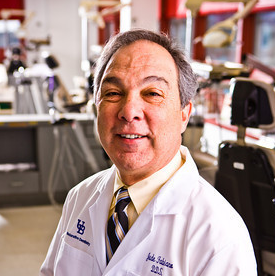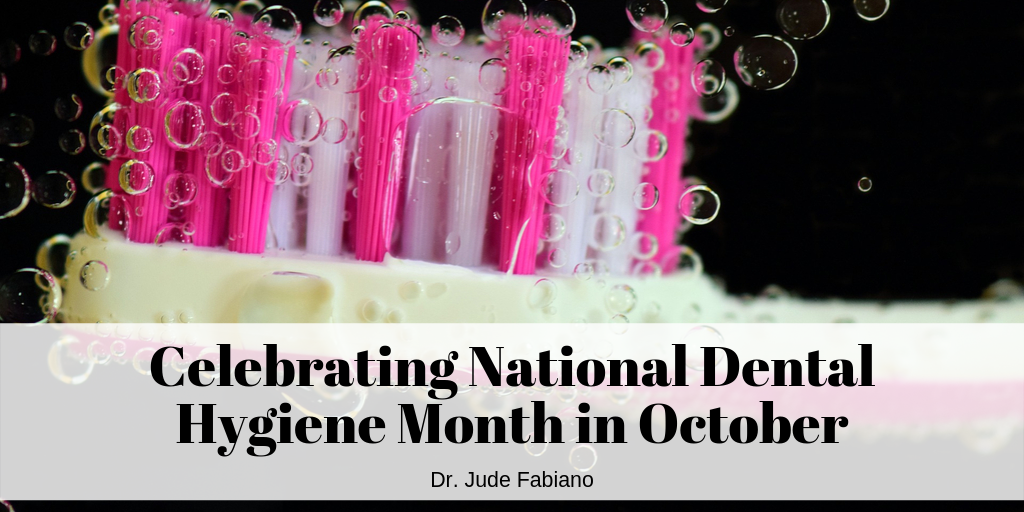About Dr. Jude Fabiano
For over 35 years, Dr. Jude Fabiano, D.D.S. has worked in the world of dentistry, establishing himself as a respected authority on the subject in the greater Buffalo area. During the late 1970s, after completing his General Dental Residency, Dr. Fabiano partnered with another doctor to open a private practice for general dentistry. Dr. Jude Fabiano ran this practice for 21 years, where he saw a significant number of patients with mental and physical disabilities. This meant treating a large number of patients in the operating room, since it was impossible to treat them while they were conscious.
After 21 years at his practice, Dr. Jude Fabiano was forced to retire due to a medical condition that prevented him from practicing clinical dentistry. Dr. Fabiano then joined the University at Buffalo School of Dental Medicine, where he served as a Clinical Associate Professor, Director of the Advanced Education in General Dentistry Program and as Associate Dean for Clinical Affairs. In this capacity, Dr. Fabiano helped to develop two major organizations at the school, Counseling, Advocacy, Referral, Education and Service (CARES) and Buffalo Outreach and Community Assistance (BOCA). Dr. Jude Fabiano founded the CARES program with the School of Social Work to assist patients if they had issues, such as mental, financial or transportation-related, that prevented them from getting proper dental care. This program received significant attention from the people not only in the Buffalo area, but also throughout Western New York and Southern Ontario, and was recognized by the American Dental Association.
While CARES worked to help the people of the Buffalo area, BOCA was a missionary-type program that arranged outreach missions to provide free dental care to underprivileged areas in the rural United States, Mexico, the Caribbean, Southeast Asia and Africa. BOCA proved to not only be extremely helpful for those it serviced but also extremely rewarding for those students and dentists, including Jude Fabiano himself, who regularly took part in these outreach events.
Together with his wife of 45 years, Eileen, a 1977 graduate of the University at Buffalo’s School of Nursing, Dr. Jude Fabiano participated in nearly 20 outreach trips over the past 15 years. As an adjunct faculty member of UB’s Dental School, Eileen, an RN with over 40 years of clinical experience, worked side by side with Jude, screening hundreds of patients at each location by taking medical histories, blood pressures, blood sugars, and other medical information prior to their dental treatment. Eileen and Jude were instrumental in bringing a young woman to Buffalo for a life-threatening surgery in 2007. Her surgery and aftercare were completely donated by local surgeons and a Buffalo hospital. The young woman stayed with the Fabiano family for four months as their “guest” while they cared for her during her recovery. Her medical problem was identified during the screening process in the Dominican Republic when she came to seek dental treatment.
Dr. Jude Fabiano left the University of Buffalo in 2013 to pursue a career at Ivoclar Vivadent, Inc., a dental material company, where he currently serves as the Director of Corporate Education. In this capacity, Dr. Fabiano has been responsible for the creation of an effective, integrated learning organization for the company that works to help it not only effectively teach its staff, but also meet its business goals and fit in with their overall strategy and vision. This includes developing a solid curriculum, collaborating with management, improving the current learning program and effectively executing all responsibilities associated with corporate education.

-
Dr. Jude Fabiano DDS, the face of dentistry in the Buffalo area

Celebrating National Dental Hygiene Month in October
October is National Dental Hygiene Month! It’s probably more exciting for those in the dental industry than it is for the general public, but this month serves as a great opportunity for us all to focus on maintaining our dental hygiene.
Here are a few steps you can take this month to ensure optimal oral health.
1. Ask about your family history
If you don’t already have an accurate family history of oral health conditions, now is a great time to ask your family for more information. Properly caring for your oral health can minimize the chances of developing many conditions, but it’s good to know what you and your dentist should be looking out for.
Common conditions that have a genetic component include gum disease, tooth decay, oral cancer, and misaligned teeth or jaws.
2. Buy a new toothbrush
According to the American Dental Association, it’s best to replace your toothbrush every 3-4 months. If you can’t remember the last time you changed your toothbrush, it’s probably time. Always pick a toothbrush with soft bristles to protect your gums.
If you prefer a manual brush, it’s best to choose one with either multi-level bristles or angled bristles because they perform better. Some people find that a powered toothbrush is easier to use. This is especially true for those with dexterity problems, such as the elderly, children and people with disabilities. Both manual and powered toothbrushes are effective at removing plaque when used correctly, so you can’t go wrong either way.
Many dental professionals also recommend switching toothbrushes within a few days of recovering from an illness. This is especially true for anyone with a compromised immune system.
3. Schedule your bi-annual teeth cleaning with your dentist
You should have your teeth professionally cleaned and examined every 6 months. October is a great time to schedule your appointment because we’re all liable to forget once the excitement of the holiday season rolls around.
Personally, I recommend scheduling your next appointment before you leave an appointment. You can always reschedule the appointment for another day or time if necessary, but it’s the best way to ensure that you continue seeing the dentist regularly.
4. Spread the word!
Once you’ve made strides in taking care of your own oral health, be sure you encourage others to do the same. Put National Dental Hygiene Month on the radar for your friends, family and co-workers.
It is also a great opportunity for you to show appreciation for the dental professionals in your life, whether they be dental hygienists, receptionists, dentists, or educators.

How to Protect Kids’ Teeth from Halloween Candy
Once again, it’s the time of year when Halloween candy is a staple in kids’ diets. Dressing up and collecting candy from all the neighborhood’s houses is fun, but it can also be bad for kids’ oral health.
The bacteria in a child’s mouth thrives on the excess sugar. When sugar sits on teeth, oral bacteria produce a weak acid that is known to contribute to cavities. Parents may wonder if there is any way to minimize the damage without ruining the fun.
Pick Candy Wisely
Some sweet treats cause more damage than others. For example, sticky candies have a higher chance of pulling out existing cavity fillings, which can cause pain and sensitivity. Children should also be careful with hard candy, as it can break teeth. Hard candy also stays in a person’s mouth longer than other candy, so sugary saliva has ample opportunity to coat their teeth.
One of the better options is chocolate because it washes off teeth more easily than other types of candy. This is especially true for dark chocolate, which has less sugar than milk chocolate or white chocolate.
Set Strict Limits
Many children come home with more candy than they can eat in a reasonable amount of time. To ensure the health of their teeth and bodies, limit the amount of candy they can consume each day. Eating too much candy can mean they’re less hungry for food with nutritional value, and the excess sugar in their diets can cause other health problems.
Consider donating any excess candy to homeless shelters or organizations that can help distribute it to children who otherwise wouldn’t have Halloween candy.
Prioritize Routine
The best way to prevent tooth damage from excess candy is by washing away the damage regularly. Kids should always brush their teeth twice per day, but it’s especially important when they’re consuming excess sugar. In fact, sugar can linger between teeth where toothbrush bristles can’t reach, so this is a great time of year to also prioritize flossing.
Parents should take extra precautions by making sure kids don’t have access to candy after they’ve brushed their teeth before bedtime. It’s also important to make sure kids see their dentist regularly so they can address cavities while they’re small.
Reinforcing the importance of oral health during the Halloween season is a great way to promote healthy habits that can lead to a lifetime of healthy smiles.

Teeth Whitening: Pros and Cons
Anyone who regularly consumes coffee, tea or red wine knows that what we ingest can affect the whiteness of our smile. For people who want a white smile but don’t want to change their diet, there are professional and over-the-counter options for teeth whitening.
Both options use peroxide, a whitening agent. The peroxide product used by professionals is much stronger than over-the-counter options, but they work in similar ways.
Professional Whitening
Professional whitening can cost more than $500 and usually is not covered by dental insurance. When teeth are professionally whitened, the effects are immediate and last for years. This is because the concentrated peroxide product dehydrates the tooth while simultaneously bleaching it. As the tooth rehydrates over the next few weeks, it’s common for the teeth to darken a few shades. However, that often leads to a natural white that many people desire.
Over-the-Counter Options
If you walk into the toothpaste aisle of any store, you’ll see a plethora of strips, gels and mouthwashes that promise you a whiter smile. It will likely take multiple applications over a week or two, so it’s more of a commitment than professional whitening. However, it is the more affordable option.
Additional Considerations
As we age, our tooth enamel thins. This makes the yellow-hue of our dentin more visible, which is why yellow teeth is more common in the aging community. Bleaching products only work by removing stains from enamel, not dentin, so this is one situation where natural teeth can’t be whitened. Whitening products also won’t work on most fillings or crowns.
I’d caution people to be weary of using natural methods for teeth whitening, such as lemon juice or charcoal. These substances are risky because they can damage your tooth enamel, leading to more visible (yellow) dentin, as well as less protection from tooth decay.
If you’re considering tooth whitening of any kind, be sure to consult your dentist first. They can point you in the right direction, whether it be an over-the-counter product or a professional whitening job. They will likely also recommend a professional cleaning prior to any whitening attempt because teeth that are free from plaque, tartar and stains respond better to bleaching products.
Above all, remember that a white smile doesn’t necessarily indicate a healthy smile. Always make your oral health a priority over the physical appearance of your teeth. Anyone with sensitive teeth may be advised to avoid whitening treatments, and maintaining gum health should always be a priority.
